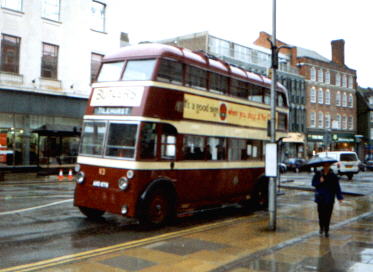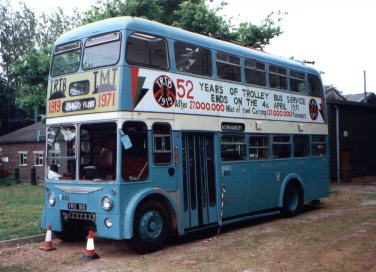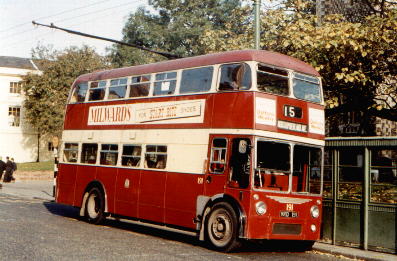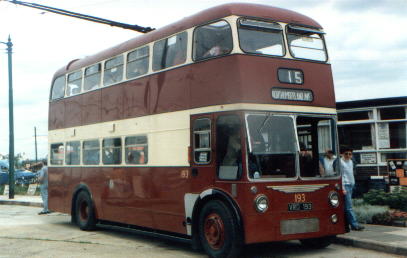Reading Corporation Transport - Trolleybuses
www.buszone.co.uk
Before this there were: Electric Tramways
On 17th December 1931 a Transport (Future Policy) Sub-committee was appointed by the Transport Committee to consider and report on the choice of vehicles available for the future of the undertaking. The report was needed so that a decision could be made regarding the future of the tramway system, the condition of which was deteriorating.
- The report was presented on 3rd May 1934, and in it's opinion:
- The Caversham-Whitley line, and the extremities of the main line were virtually life expired
- The vehicles were not expected to last beyond 1941
- The power station would not last more than four years.
Also
- Trams were considered out of date
- Petrol-driven motorbuses were not favoured because of heavy taxation and high fuel prices
- Diesel-engined motorbuses were still in their experimental stages, and so were seen as unsuitable as an alternative
- Trolleybuses were considered the ideal replacement, although not being able to overtake or turn around without special arrangements they were electrically driven, easier to repair and quiet running.
So, initially powers were sought to operate trolleybuses between:
- Tilehurst (Park Lane) - Earley ("Three Tuns")
- Tilehurst ("Roebuck") - Earley ("Three Tuns")
- Caversham Heights - Shinfield Road
- Emmer Green - Lower Whitley
- Broad Street - Whitley Housing Estate
- London Road - Bath Road (Horncastle)
- Erleigh Road - Norcot Road
- Bridge Street (Caversham) - Lower Caversham
Not all of these powers were used however, some were slightly altered before trolleys operated along them and others ended up being operated by motorbuses.
The first Trolleybus arrived on 31st March 1936, and was numbered 1. It was a former demonstrator for Sunbeam and so could be delivered much more quickly than any new vehicles ordered. This allowed it to be used for training purposes, for which a training loop was set up along Erleigh Road. The bus wasn't licensed for use straight away, and is presumed to have been licensed from 1st May 1936. Free rides were also given along the training loop to members of the public so that they could try out the new buses, tickets were acquired by writing to the department's offices in Mill Lane on personal application. It was decided to convert the Caversham - Whitley line first because the tram lines on the route were the worst overall. The route required five vehicles, and as five trolleybus manufacturers had put in tenders to supply the vehicles it was decided to purchase one of each so the company could best assess which type to standardise on in the future. A new depot was constructed on the site of the Tram depot at Mill Lane, extra track was laid so that trams could be parked in the motor bus sheds next to the old depot during construction. The vehicles arrived in July 1936 (see Former Vehicle Fleet List), and the Caversham - Whitley service started on 18th July 1936, with 1, 2, 3, 6 and 4 operating.
Proposals for the conversion of the main line were considered next, this was from Tilehurst (Park Lane/Langley Hill junction) to Earley ("Three Tuns"), and included the tram branch line in London Road. The experimental vehicles had been watched closely, and tenders for new Trolleybuses were sought. It had been found that the AEC vehicle, number 2 was the best choice, and the Sunbeam, number 6 was second. The tender from AEC was the same as Sunbeams, and was joint at second lowest price. Because the AEC construction site was only 27 miles away, and on the main train line which passes through the town, it was decided to take the AEC tender, an order for 25 vehicles was placed, all with Park Royal bodywork. New trolleybus wires were erected on the route, the trams were transferred to the trolleybus positive wire wherever possible, and then tram wire could be taken down. New substations (to supply power) were built at Crescent Road (Wokingham Road), Catherine Street (Oxford Road), Norcot ("Rex" Cinema) and Tilehurst (Kentwood Hill). The new trolleybus depot was completed whilst all this work was being undertaken, all the changes being complete on 28th November 1938. The first vehicles 1-6 were renumbered 101-6 in November/December 1938 (see Former Vehicle Fleet List). The first of the AECs, 107, arrived on 14th December 1938, the remainder at a rate of 2-3 per week until the last, 128 came on 18th April 1939 (see Former Vehicle Fleet List). Trolleybus operations on the main line commenced on Sunday 21st May 1939. The routes that were originally operated using the main line were:
- Route A Tilehurst - Norcot Road Junction - "Three Tuns"
- Route B Norcot Road Junction - "Three Tuns"
- Route D Norcot Road Junction - London Road
- (Route C was Caversham - Whitley)
Routes A and B ran every ten minutes, combining on common sections to give a frequency every 5 minutes and route D operated every 15 minutes. However on 3rd September 1939 Britain declared war on Germany. During the hours of darkness a blackout had to be kept so that enemy bombers would not see the town, this meant that schedule changes had to be made because the trolleybuses had to run slow. From 3rd August 1940 changes were also made to destination names so that as little geographical information was given out as possible should an enemy invasion occur:
- Caversham became Promenade
- Whitley became Whit Pump
- Tilehurst became Bear Inn
- London Road became Liverpool Road
- Wokingham Road became Three Tuns
Also Reading was painted out from below the Borough crest on both sides of each vehicle and from the legal ownership panel. The cast stone over the power station at the depot saying "Reading Corporation Tramways Power Station" was also boarded over. Problems then started to arise due to increasing loadings, the mainline was starting to become overcrowded. The town's population had increased from 100,000 to 140,000 in two years with people being evacuated from London to the surrounding towns. After unsuccessfully enquiring about hiring surplus motorbuses or trolleybuses from municipal operators in southern England six new Trolleybuses with Park Royal utility bodywork and Sunbeam W Chassis were ordered in 1942, and arrived in 1943. Also in November 1943 powers were approved to extend the mainline from Norcot to the junction of Oxford Road with Kentwood Hill to allow the replacement of a motorbus service and economies to be made with fuel. The extension was opened on 31st July 1944. In 1947, after the war most trolleybus termini reverted to their old names, apart from Liverpool Road which remained the same.
In 1947 20 new trolleybuses were ordered, with BUT chassis and Park Royal bodywork to open a new line to Whitley Wood. In the September of that year it was decided that another 12 vehicles should be purchased to replace the original six trolleybuses and to augment the over-stretched fleet (of 37 vehicles in the fleet 36 were needed for service each day, a very tough target to meet). However, there was great demand nationally for new trolleybuses and the war meant that it could be two years before these buses arrived, so second hand trolleybuses were looked at. Very few were available for purchase, and those were mostly very old. However Huddersfield had a batch of 12 Karrier E6 three-axle trolleybuses due for early withdrawal on receipt of their new vehicles. Initially authority was given to the General Manager to purchase between five or ten of these vehicles, it was not expected that they would be able to buy all of them because another undertaking had also expressed an interest in them. However Reading eventually purchased all twelve. They arrived in very poor condition, so plans to put them straight into service were soon scrapped. A program of virtual re-building was planned, before they entered service. However by the time the first, 158, entered service the number planned for re-build was dropped to ten, the other two being used for spares. Later the number was again dropped to six (see Former Vehicle Fleet List). For the Whitley extension two new substations were needed, they were built at the Christchurch Gardens junction with Basingstoke Road and on Basingstoke Road near the junction with Buckland Road. It was also becoming clear that the depot in Mill Lane was not going to be large enough, so an extra site was found on Bennet Road. By 1948 the specifications for the 12 new trolleybuses was finalised and a tender from Sunbeam for their S7 type with Park Royal bodywork was accepted. As the new BUTs arrived in 1949 the new Whitley line was not quite ready, so they initially entered service on the main line. The opportunity was then taken to withdraw 101, 103 and 105 (see Former Vehicle Fleet List). New Route E (only referred to as this internally) from Northumberland Avenue to Caversham Bridge commenced on 5th June 1949. By this time the original route D had been absorbed into routes A, B and C so the new Whitley Wood - Stations service became route D and commenced on 7th August 1949.
Services were reorganised on 24th April 1950, all vehicles from Kentwood operated to Liverpool Road, and vehicles from Norcot all travelled to Wokingham Road. On 7th August 1950 a turning circle at South Reading Community Centre was ready, so regular short workings commenced to and from that point on this date. The first six of the S7s, 170-5, entered service on 1st November 1950 (see Former Vehicle Fleet List), and the two original trolleybuses that still remained, 102 and 106, were withdrawn, 104 had been withdrawn at the end of 1949. Also withdrawn were AECs 107-112, but it had not been decided what to do with them. The last six of the S7s, 176-80 entered service on 1st December 1950, with the six utility Sunbeams 132-7 being withdrawn the day before. On 15th December it was decided not to sell 107-12, and to store them at Bennet Road. The official opening of the Bennet Road depot was on 14th January 1952, the site however being used for storage for a couple of years before this, and the depot used once or twice before the opening. Complete body overhauls were carried out on 112-4, 120 and 127-31 from December 1952, 112 replacing 126, which was withdrawn after overturning on Oxford Road. It was also decided in 1955 to re-body the withdrawn AECs 107-11 as replacements for the Karriers, which were becoming unreliable.
AECs 115-8 were withdrawn on 30th April 1958 (119 went after an accident on 27th February 1958) because they were surplus to requirements with increasing motor car usage causing passenger numbers to reduce. Also the Bennet Road depot was closed, and the space rented out because the extra capacity was no longer needed due to these recent withdrawals. An extension to Armour Hill from Kentwood was opened on 4th August 1958, but even with this increase in requirements the decline in patronage was such that on 21st September 1958 AECs 121-125 were withdrawn. The S7s were rebuilt from 1957-62 as the bodies were showing a lot of wear and tear, some panels rattling and occasionally working loose. In June 1960 the purchase of 12 new Sunbeam trolleybuses was confirmed with Burlingham bodywork. They entered service in May and June 1961. Route letters were shown for the first time by these vehicles, but only on the rear. At this time the routes were:
- Route A: Tilehurst - Wokingham Road
- Route C: Armour Hill, Kentwood - Liverpool Road
- Route D: Whitley Wood - Stations/St. Mary's Butts
- Route E: Northumberland Avenue - Caversham Bridge/Stations/St. Mary's Butts
Erection of traction poles for an extension further along Northumberland Avenue started on 2th July 1962, and was ready by the middle of October. Services commenced on the new section on 13th January 1963, with the frequency being improved at the same time.
Route numbers were introduced on all of the undertaking's routes on 9th August 1964. The numbers allocated to the trolleybus routes were:
- 15 Northumberland Avenue - Stations or Caversham Bridge (formerly route letter E)
- 16 Whitley Wood - Stations (formerly route letter D)
- 17 Wokingham Road - Tilehurst (formerly route letter A)
- 18 Liverpool Road - Armour Hill, Kentwood (formerly route letter C)
On 17th March 1965 it was decided to abandon the Caversham Bridge section as soon as possible because patronage on the trolleybuses was very light, there were three other motorbus services serving the road and the service only operated weekdays until 7.30pm anyway. The last day of operation on this section came on 10th July 1965. Also at this time the routing of services to the Stations was altered in preparation for a one way system in the town centre with new wiring being erected.
In 1965 the virtual sole supplier of trolleybus cables gave a statement to all trolleybus operators that because of diminishing orders it was becoming difficult to manufacture stocks in economical quantities. Later in the year it announced it's intention to cease production altogether by the end of the year. At the same time Reading's Trolleybuses started to receive some bad publicity in the press because they cost more to operate compared to motorbuses and they were so inflexible. (These articles failed to mention however that the trolleybuses made a profit, and motorbuses a loss in the last financial year, and that trolleybuses were much faster, cheaper to purchase and maintain, and less polluting.) At the Council meeting on 26th July 1966 the chairman of the transport committee had to propose his committee's decision to abandon the trolleybus system (even though he did not agree). The full Council voted in favour of the proposal, meaning that an end to trolleybus operation in Reading was in sight.
It was decided at the Transport Committee meeting on 28th September 1966 that the Whitley Wood trolleybus service should be abandoned no later than on the 1st January 1967. Roadworks were currently underway near the terminus in Whitley Wood, and the turning arrangements would need to be altered if there was any further delay in the abandonment of this section. Also the new Inner Distribution Road being built outside the Mill Lane depot would seriously affect the operation of trolleybuses between St.Mary's Butts and Stations. So, to avoid any unnecessary expenditure in construction it was decided that the Whitley line should be first to go, now that abandonment was certain. The withdrawal of eight of the BUT trolleybuses (not in fleet number sequence) took place in December 1966 and January 1967. The last day for the Stations - Whitley Wood section came on Sunday 8th January 1967.
In June 1967 a purchase of 28 Bristol RE motorbus chassis was made to replace the final trolleybuses (see Former Vehicle Fleet List). In August Pennine bodywork was ordered for them. As they started to arrive in December 1967 the final day of regular operation came for the Northumberland Avenue section on Sunday 17th December 1967. The following day motorbuses were substituted on all but two morning peak extra duties which remained scheduled for trolleybus operation (in reality only one of those ran), but the line was left intact in case of any problems with the pre-Christmas rush. In fact only two days after the closure something did happen, a trolleybus was substituted for a motorbus due a shortage of motorbuses! This led to a decision to re-instate trolleybuses from 19th December on three afternoon duties. Eventually Friday 22nd December turned out to be the last day of trolleybus operation on the route to any noticeable degree, but the last service trolleybus to actually use the route was on 29th December 1967. The terminus was used for the last time on Sunday 30th December 1967 for a tour of the whole system by the National Trolleybus Society.
The next route for conversion was the 18, conversion originally being planned for 17th March 1968, but was advanced by two weeks to coincide with the conversion of former trolleybus route 15 to one-man single-deck operation. This meant that the double deck Dennis Loline motorbuses could be used on service 18. The last day was on Sunday 3rd March 1968. The turning circle at Cemetery junction was used for the last time on 17th February 1968. This then left only the main line, route 17, being scheduled for abandonment in the summer of 1968 on arrival of the 28 Pennine-bodies Bristol REs. Following the closure of route 18, 6 BUTs were withdrawn.
Delivery of the 28 REs started in March 1968, and 14 were expected by May/June. The first contraflow bus lane in Britain was introduced on 16th June 1968 when Kings Road became one way eastbound. It generated great interest, and a special video was made explaining it. The contraflow lane survived almost 20 years, until 22nd June 1988 when the road became two way again, but the lane still remains as a bus lane.
The final day of operation of route 17 came on Sunday 3rd November 1968, the final trolleybus in normal service was 182 with 185 arriving just in front after a duel at the traffic lights when the buses met in town coming from opposite ends of the route. After this, 144, the final trolleybus carried a party of guests and invited VIPs on the final run to Tilehurst. It was led by 174 and 181, the guests were loaded aboard 144 and 181 and 174 acted as relief, spare seats being made available to enthusiasts just before moving off. Huge crowds lined the streets and a large crowd was at Mill Lane to see the final bus turn into the depot. Following this the Mayor pulled the switch in the depot sub-station cutting the power to the overhead wires. By midnight all the trolleybuses had been towed away from the depot to Bennet Road, 185 being the last to leave. The very last trolleybus then to leave Bennet Road was 188 on 11th May 1969.
Of the vehicles operated by Reading 113, 144, 174, 181, 186 (in Teesside livery) and 193 are in preservation (see Former Vehicle Fleet List). They represent each type of Trolleybus operated by the undertaking apart from the original six 'test' vehicles. Below are some photographs of these vehicles:
Here is preserved AEC 113 in October 1998 on the newly pedestrianised Broad Street.
Preserved 113 in action at the Sandtoft Transport Centre on 28th July 2002.
Preserved 181 on display at the Sandtoft gathering on 28th July 2002.
This is Sunbeam F4A 186, which is preserved in Teeside livery. It became Teeside's last trolleybus after it was sold by Reading Corporation. This photograph was originally from the W. Ball collection.
This is Sunbeam F4A 191 at St.Mary's Butts, it is just past the turning circle that was sited there. This photograph was originally from the W. Ball collection.
This is preserved Sunbeam F4A 193 doing a special tour after Reading's system was closed. This photograph was originally from the W. Ball collection.
Thanks to Dave Hall for assistance with the information on this page.Some of the last Trolleybus traction poles were removed from Whitley Wood Lane in November 2017, leaving some at the far end of Northumberland Avenue and Kentwood Hill.
Related sites to Visit:
- David Bradley Online Trolleybus Picture Gallery
- Maypine Trolleybus Company - One Third Size Model of Reading 182
- 'The Trolleybus Centre at Sandtoft'
After these came: Motorbuses



